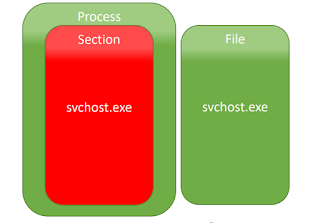Doppelgänging and Digital Forensic Analysis
Read Time: 10 Minutes
Recently, Catalin Cimpanu released a article about a new Process Hollowing Technique named Doppelgänging. The highlights of the article include undocumented features of the Microsoft Windows operating system, antivirus inability to scan NTFS transactions, and "...cannot be patched since it exploits fundamental features and the core design of the process loading mechanism in Windows". The article further discloses that BlackHat EU would be releasing the presentation.
Applying what is known about NTFS, and the associated API Calls, the way Windows handles caching is called lazy write caching. Effectively, the changes are stored in memory for a period of time before being committed to disk and the transactions are stored in the $LogFile. This allows for analyst to discovery the aforementioned behavior, the malicious code in play, and timing of events.
Another assertion made by the authors of the presentation during the Detection/Prevention section is that Forensics can check for "...WriteAccess == TRUE for the FILE_OBJECT associated with process". This was paired with a statement that "Even advanced forensics tools such as Volatility will not detect it". The first assertion can be found using Volatility making the second assertion wrong. There is a module called filescan that reveals the permissions of the executive object type called "FILE_OBJECT":
Also, the module called "volshell" you can also query on FILE_OBJECTS of interest to see their full meta data:
Based on the information available it would seem that a careful analyst can find this technique in play using a blend of Memory Forensics and possibly Disk Forensics.
Please leave comments below and I look forward to sharing more experiences that I have on the daily with my readership.
Recently, Catalin Cimpanu released a article about a new Process Hollowing Technique named Doppelgänging. The highlights of the article include undocumented features of the Microsoft Windows operating system, antivirus inability to scan NTFS transactions, and "...cannot be patched since it exploits fundamental features and the core design of the process loading mechanism in Windows". The article further discloses that BlackHat EU would be releasing the presentation.
So I found the powerpoint of the presentation, titled Lost in Transaction: Process Doppelgänging, which reveals the API Calls and some interesting assertions by the researchers. You can find additional information about NTFS Transactions on Microsoft Developer Network (MSDN) shows some basic information regarding the API Calls referenced in the presentation. The sequence of API calls according to the presentation is as follows:
- Create a transaction
- Open a "clean" file transacted
- Overwrite the file with malicious code
- Roll back the changes to the file on disk
Another assertion made by the authors of the presentation during the Detection/Prevention section is that Forensics can check for "...WriteAccess == TRUE for the FILE_OBJECT associated with process". This was paired with a statement that "Even advanced forensics tools such as Volatility will not detect it". The first assertion can be found using Volatility making the second assertion wrong. There is a module called filescan that reveals the permissions of the executive object type called "FILE_OBJECT":
Please leave comments below and I look forward to sharing more experiences that I have on the daily with my readership.
References
- Catalin Cimpanu Author of "Process Doppelganging attacks works on all windows versions" https://www.bleepingcomputer.com/author/catalin-cimpanu/
- "Process Doppelganging attacks works on all windows versions" Article https://www.bleepingcomputer.com/news/security/-process-doppelg-nging-attack-works-on-all-windows-versions/
- enSilo "Lost In Transaction Process Doppelganging" https://www.blackhat.com/docs/eu-17/materials/eu-17-Liberman-Lost-In-Transaction-Process-Doppelganging.pdf
- MSDN "Transactional NTFS" https://msdn.microsoft.com/en-us/library/windows/desktop/aa964931(v=vs.85).aspx
- MSDN "File Caching" https://msdn.microsoft.com/en-us/library/windows/desktop/aa364218(v=vs.85).aspx
- Brain Carrier "File System Forensic Analysis" https://www.pearson.com/us/higher-education/program/Carrier-File-System-Forensic-Analysis/PGM270599.html
- Volatility Framework Wiki https://github.com/volatilityfoundation/volatility/wiki/Command-Reference#filescan






Comments
Post a Comment